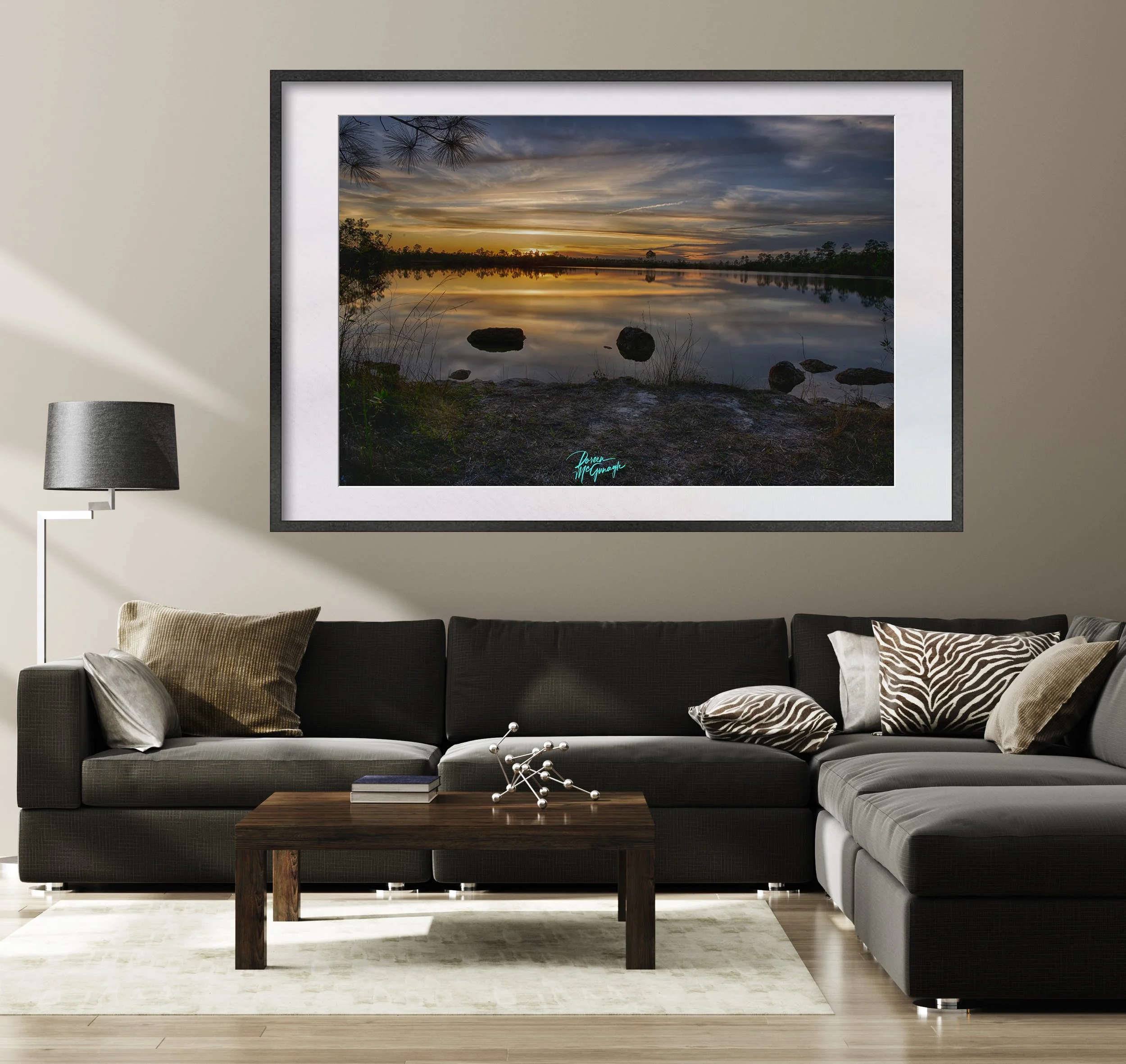Finding Harmony in Nature: The Art of Balance in Our Limited Edition Prints
Nature has a way of captivating us with its beauty and grandeur. From the majestic mountains to the serene lakes, every part of nature has a story to tell. As photographers, we are fortunate to be able to capture these moments and share them with the world. But, to create stunning images, we need to master the art of balance and harmony.
Sunset over Lake in Everglades National Park
The artist skillfully captures the rich colors of the setting sun, reflecting off the calm waters of the lake. The oranges, pinks, and purples blend together in a mesmerizing display, transporting the viewer to a peaceful moment in nature.
Not only is this piece visually stunning, but it also captures the essence of the Everglades, a unique and fragile ecosystem that is home to a diverse range of wildlife. By purchasing this artwork, you are not only adding a beautiful piece to your collection, but also supporting the preservation of this important natural area.
This piece would be the perfect addition to any home or office, bringing a sense of calm and serenity to any space. Imagine hanging this artwork in your living room, where you can admire it while relaxing on the couch, or in your office, where it can provide a moment of respite during a busy workday.
The art of balance is essential in nature photography. It involves arranging the various elements in a photograph in a way that creates a sense of equilibrium. When we look at a balanced photograph, our eyes move smoothly across the image, and we feel a sense of calmness and stability.
One way to achieve balance in photography is by using the rule of thirds. The rule of thirds involves dividing an image into three equal parts, both vertically and horizontally, and placing the main subject of the image at one of the four intersecting points. This creates a visually pleasing composition that draws the viewer's eye to the subject.
Another way to create balance is by using symmetry. Symmetrical images have a mirror-like quality, and the elements in the photograph are evenly distributed on both sides of the image. This creates a sense of order and stability, and the viewer's eye is drawn to the center of the image.
However, achieving balance doesn't always mean creating a perfectly symmetrical image or adhering to the rule of thirds. Sometimes, an image can be balanced by using a focal point. A focal point is the element in an image that draws the viewer's eye. By placing the focal point off-center, we can create a sense of balance and harmony, even if the image isn't symmetrical.
In nature photography, creating harmony is just as important as achieving balance. Harmony involves using color, texture, and contrast to create a sense of unity in the image. When we look at a harmonious photograph, the colors and textures blend together seamlessly, and we feel a sense of peace and tranquility.
One way to create harmony in nature photography is by using complementary colors. Complementary colors are opposite each other on the color wheel, such as blue and orange or yellow and purple. By using complementary colors in an image, we can create a sense of balance and harmony.
Texture is another element that can be used to create harmony in nature photography. Texture refers to the surface quality of an object, such as the roughness of tree bark or the smoothness of a lake's surface. By including different textures in an image, we can create a sense of depth and dimensionality, which adds to the overall harmony of the photograph.
Bald Cypress Trees at Cypress Creek North Natural Area
The print features a high-contrast black and white image of the Bald Cypress Trees at Cypress Creek North Natural Area, a stunning and serene location known for its picturesque landscape and natural beauty. The trees, which are the focus of the print, stand tall and proud, their twisted trunks and branches reaching towards the sky. The surrounding foliage is equally captivating, with delicate leaves and intricate details that are brought to life in the fine art print.
Contrast is also essential in creating harmony in nature photography. Contrast refers to the difference between light and dark areas in an image. By using contrasting elements, such as a dark tree against a light sky or a colorful flower against a muted background, we can create a sense of balance and harmony.
At our limited edition photography prints, we strive to create images that are both balanced and harmonious. We carefully consider every element in the image, from the placement of the focal point to the color and texture of the objects in the photograph. By doing so, we create images that are not only aesthetically pleasing but also evoke a sense of peace and tranquility.
Our limited edition prints are carefully crafted to ensure that each image is a work of art. We use the finest materials and printing techniques to ensure that our images are of the highest quality. Each print is individually signed and numbered, making them a true collector's item.
In conclusion, the art of balance and harmony is essential in nature photography. By using composition, color, texture, and contrast, we can create images that are not only beautiful but also evoke a sense of peace and tranquility. Our limited edition prints are a testament to this, and we are proud to share them with the world, hoping to inspire others to appreciate and protect the beauty of nature.


